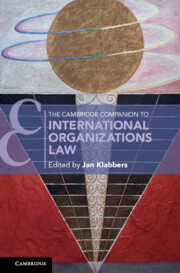Book contents
- The Cambridge Companion to International Organizations Law
- Cambridge Companions to Law
- The Cambridge Companion to International Organizations Law
- Copyright page
- Contents
- Contributors
- Acknowledgements
- Cases
- Introduction
- 1 Beyond Functionalism
- 2 The Concept of International Organization
- 3 Accountability
- 4 Inclusion and Exclusion in International Organizations
- 5 A Legal Framework on Internal Matters
- 6 Standard-Setting in UN System Organizations
- 7 Operational Activities
- 8 Deliberation
- 9 Teaching Statehood
- 10 Interaction between International Organizations
- 11 The International Organization for Migration and the Duty to Protect Migrants
- 12 Global Health
- 13 Energy Provision
- 14 International Organizations, Disarmament and State Behaviour
- 15 International Organizations and Stories of Development
- 16 Food Security and International Organizations
- 17 Financial Stability
- Epilogue
- Bibliography
- Index
Epilogue
Published online by Cambridge University Press: 31 March 2022
- The Cambridge Companion to International Organizations Law
- Cambridge Companions to Law
- The Cambridge Companion to International Organizations Law
- Copyright page
- Contents
- Contributors
- Acknowledgements
- Cases
- Introduction
- 1 Beyond Functionalism
- 2 The Concept of International Organization
- 3 Accountability
- 4 Inclusion and Exclusion in International Organizations
- 5 A Legal Framework on Internal Matters
- 6 Standard-Setting in UN System Organizations
- 7 Operational Activities
- 8 Deliberation
- 9 Teaching Statehood
- 10 Interaction between International Organizations
- 11 The International Organization for Migration and the Duty to Protect Migrants
- 12 Global Health
- 13 Energy Provision
- 14 International Organizations, Disarmament and State Behaviour
- 15 International Organizations and Stories of Development
- 16 Food Security and International Organizations
- 17 Financial Stability
- Epilogue
- Bibliography
- Index
Summary
The chapters collected in this Cambridge Companion together demonstrate a few things about the law of international organizations – and law generally perhaps – that may not always be realized. A first point to note is that international organizations are active in nigh-on all walks of life, as these chapters suggest. There are few human activities with which international organizations have no point of contact. Whether it concerns energy provision or the movement of persons across the globe; whether it concerns disarmament or financial stability or the governance of resource extraction, international organizations are often involved in one way or another. And even in those policy domains where there is no single overarching international organization (most conspicuously perhaps the heavily fragmented domain of environmental protection), there are nonetheless entities active which may not generally be considered international organizations (largely because their founding fathers shy away from using that label), but which are remarkably similar to international organizations in all but name.
- Type
- Chapter
- Information
- The Cambridge Companion to International Organizations Law , pp. 422 - 425Publisher: Cambridge University PressPrint publication year: 2022

